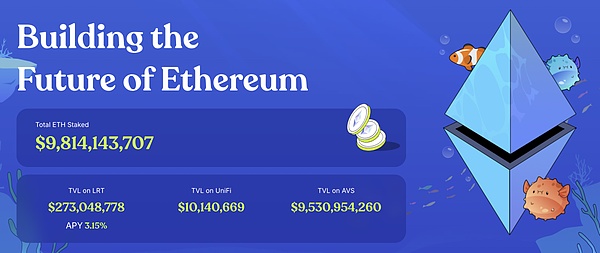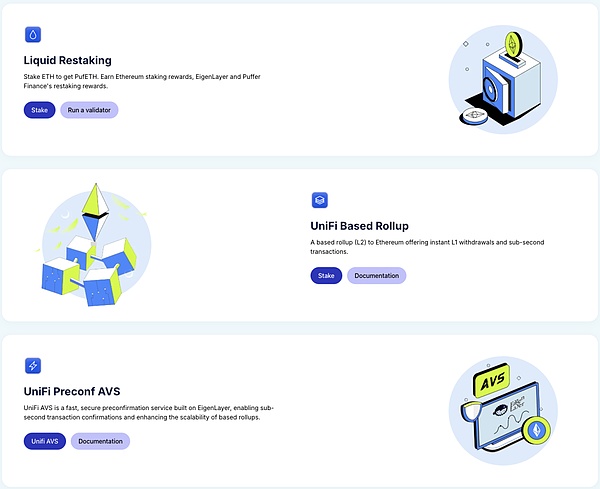In the Ethereum ecosystem, staking services are an important cornerstone of network security and decentralization. However, the traditional staking mechanism still faces many challenges in terms of threshold, efficiency and income distribution. As an innovative infrastructure of Ethereum, Puffer has completely reshaped the Ethereum staking ecosystem with its liquidity re-staking (nLRT), Puffer UniFi based on Based-Rollup technology, and pre-confirmation technology UniFi-Preconf-AVS, bringing new opportunities to users and node operators. This article will comprehensively analyze Puffer's technical highlights and business model, and explore its far-reaching significance for the decentralization and sustainable development of Ethereum.

About Puffer
Puffer is an innovative infrastructure for Ethereum. Its core products include:
Liquidity Re-Pledge (LRT):Through the native liquidity re-pledge protocol, it provides services for starting nodes with as low as 2 ETH, and is equipped with anti-slashing technology;
UniFi-Based-Rollup: Built on Based-Rollup technology, it solves the challenge of Ethereum liquidity fragmentation and provides permissionless vertical qualification services; UniFi-Preconf-AVS: Through preconfirmations technology, transaction time is greatly shortened, making the user experience of Based-Rollup comparable to other high-performance Rollup technologies.

The three core products have clear goals
For users:Solve the challenge of Ethereum liquidity fragmentation and greatly improve transaction speed while maintaining a high degree of decentralization;
For Ethereum nodes:By providing sustainable returns, help Ethereum further achieve decentralization, thereby enhancing its trusted neutrality.
Business Analysis
Puffer further creates more potential returns for Puffer pledgers by building the UniFi application chain and technology stack and the UniFi-AVS for pre-confirmation.

puffer-UniFi-Based-Rollup and Technology Stack
Compared with Optimistic-Rollup and ZK-Rollup, the biggest difference between Based-Rollup is the difference in transaction ordering. OP-Rollup and ZK-Rollup transaction ordering requires twice (once at Layer2 + once at Layer1). The transaction sorting of Based-Rollup is all at the Layer1 level, which means the highest degree of decentralization (Layer2 generally adopts a centralized sorting mechanism at present), eliminating single point failure and malicious risks, and all Ethereum stakers can benefit.
Puffer plans to build its own UniFi-Based-Rollup and promote the UniFi technology stack to achieve an ecosystem similar to OP-Superchain.
However, since Based-Rollup and Layer1 have the same block time (12s/block), it is not enough to meet application needs. How to improve user experience, especially transaction speed, becomes very important.
puffer-UniFi-Preconf-AVS
UniFi-Preconf-AVS is the preconfirmations technology, which can greatly shorten the waiting time (on the order of 100 milliseconds) of users when using UniFi-Based-Rollup, making the user experience of Based-Rollup comparable to OP-Rollup and ZK-Rollup. Therefore, UniFi-Based-Rollup is a complete and competitive system with the support of UniFi-AVS. All re-stakeholders who provide verification services for UniFi-AVS can benefit.
Puffer UniFi's first-stage testnet (developers only) has been completed, and the second-stage testnet (for the public) will be launched soon.
Puffer provides a permissionless, verticalized Ethereum staking service (LST+LRT), which belongs to the native liquidity re-staking protocol (Native LRT, nLRT).
Typical liquidity staking protocols, such as LidoDAO, RocketPool, etc. Typical vertical protocols, such as Ether.fi, Puffer, etc. Only LRT service protocols are provided, such as KelpDAO.
There are three important roles in the Ethereum liquidity pledge service system, namely ETH pledgers (Staker), node operators (Node-Operator), and liquidity pledge agreements.
The pledger deposits ETH into the liquidity pledge agreement and obtains a liquidity pledge certificate ➡ The liquidity pledge agreement and the node operator jointly start the Ethereum verification node, and the node operator is responsible for operating it to earn PoS verification income ➡ The PoS verification income is returned to the pledger as agreed, and the rest is used as protocol fees and node operator fees.

Starting an Ethereum verification node has the following pain points:
1. The entry threshold is too high, 32ETH is required to start, and the capital utilization rate is low;
2. In order to avoid the risk of being fined due to node offline, the common practice in the industry is to run one node with two devices (that is, one device is in standby status as a backup), but this further creates a double-signature risk, and the fines brought about by the double-signature risk are more severe;
3. The yield of Ethereum staking has declined as the Ethereum staking rate has increased, but the emergence of Eigenlayer is expected to systematically solve the problem of continued low yields;
4. The Ethereum verification node is started through the liquidity staking agreement. Most agreements use a whitelist mechanism and do not require permission.
Take the opportunity to solve the above industry pain points and independently develop a unique anti-forfeiture technology and a node operation mechanism with as low as 2ETH.
puffer anti-slashing technology
This technology consists of two modules: secure signature (Secure-Signer) and remote authentication (RAVe, Remote-Attestation-Verification).
The secure signature module uses the trusted execution environment (TEE) to store the verifier public key required for custodial node verification. TEE can guarantee the security of the verifier public key to the highest degree, which is comparable to the security level of cold wallets.
The remote authentication module is used to verify whether the secure signature module is operating normally, and to extract the verifier public key in a secure environment to complete the remote signature.
Through the above-mentioned anti-severance technology, the risk of severance is minimized, thereby having the possibility of improving capital efficiency.
In addition, puffer monitors the operating status of puffer nodes through the Guardians module to prevent nodes from being fined for a long time due to offline, ensuring that node operators do not suffer serious losses in funds.
Puffer can start nodes and validator-tickets mechanism as low as 2ETH
Node operators start puffer nodes by paying 2ETH as collateral and purchasing validator tickets.
The benefits of starting a node with as little as 2ETH are: i) the more nodes you operate, the higher the probability of being randomly selected as a verification node, the higher the rate of return, and the higher the capital utilization rate; ii) it greatly reduces the entry threshold and indirectly increases the degree of decentralization of Ethereum.
VT is equivalent to the ticket to start a node. The introduction of this mechanism helps to constrain node operators (to avoid loss of income or even principal for liquidity pledgers), and is also equivalent to prepaying pledge income to pledgers. It should be noted that the VT price will change with the increase or decrease in the demand for node startup.
Because of the emergence of Eigenlayer, Ethereum pledgers have brought more income. Liquidity pledge certificates are re-pledged, and Eigenlayer's Active Verification Service (AVS) lends Ethereum security consensus to application chains, infrastructure and other projects in need in exchange for re-pledge income.
Puffer is a vertical pledge service agreement. The pufETH it issues is a liquidity re-pledge certificate, which can obtain PoS verification income and AVS verification income at the same time.
Valuation Analysis
This article only provides valuation methodology, not specific conclusions.
Vertical staking service valuation
Method 1: The amount of ETH pledged through ether.fi is about 2.1M, the market value of ether.fi is about $330M, and the amount of ETH pledged through puffer is about 220k, which can be used to get the valuation of puffer staking service.
Method 2: The amount of ETH pledged by puffer * ETH price * annualized staking rate (LST+LRT) * puffer protocol rate * PE, which can be used to get the valuation of puffer staking service.
UniFi and UniFi AVS Valuation
Public chain Transactions are the key indicator for calculating income; Transactions * Gas * Margin * PE, the valuation of puffer UniFi + UniFi AVS can be obtained.
Risk Warning
It is necessary to pay attention to the risks such as unclear Puffer protocol rates, unclear re-staking income, uncertainty in UniFi ecological development, and protocol loopholes. Puffer attaches great importance to protocol security. In the past year, Puffer hired four professional code auditing companies in the industry (Blocksec, Creed, Nethermind, Slowmist) to complete four code audits respectively, and the risk of protocol vulnerabilities is relatively low.
Conclusion
Puffer has solved multiple pain points in the Ethereum staking ecosystem through innovative technical design and profound industry insights. Its native liquidity re-staking, UniFi-Based-Rollup and pre-confirmation technology not only optimize the user experience, but also help the decentralization process of the Ethereum network. Against the background of rapid development of the industry, the emergence of Puffer provides a new industry benchmark, and its future potential deserves continued attention and expectations.
 Joy
Joy









